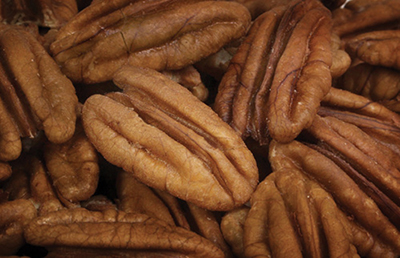Guide Z-502
Revised by Don Blayney, Richard Heerema, and Paul Gutierrez
College of Agricultural, Consumer and Environmental Sciences
Authors: Respectively, Affiliated Research Faculty, Department of Agricultural Economics and Agricultural Business; Extension Pecan Specialist, Department of Extension Plant Sciences; and Extension Specialist, Department of Extension Economics, New Mexico State University.(Print Friendly PDF)
Although there are U.S. Department of Agriculture (USDA) grades for pecans, most buyers regard them as inadequate. Buyers feel they can use their own grading system more efficiently. A recent action by pecan growers may result in some changes in the USDA grades. On May 6, 2016, the USDA announced the passage of a Federal Marketing Order (FMO) for pecans by an overwhelming majority of pecan growers in the 15-state producing area of the U.S. The final rule was published in the Federal Register of August 4, 2016, and took effect the following day, August 5, 2016. The published summary reads:

"This rule establishes a marketing agreement and order (order) for pecans grown in the states of Alabama, Arkansas, Arizona, California, Florida, Georgia, Kansas, Louisiana, Missouri, Mississippi, North Carolina, New Mexico, Oklahoma, South Carolina, and Texas. The order provides authority to collect industry data and to conduct research and promotion activities. In addition, the order provides authority for the industry to recommend grade, quality and size regulation, as well as pack and container regulation, subject to approval by the Department of Agriculture (USDA). The program will be financed by assessments on handlers of pecans grown in the production area and will be locally administered, under USDA oversight, by a Council of seventeen growers and shellers (handlers) nominated by the industry and appointed by USDA." (81 Fed. Reg. 51298)
Most buyers use a three-grade system, which consists of Fancy or Select, Choice, and Standard or Ambers. The Fancy grades are the highest quality and Amber grades the lowest. Pecans are placed into one of these three grades using the following criteria: nut size, meat size, color of the meats, and the shell-out percentage of the nut. The shell-out percentage refers to the amount of nutmeat yield relative to the weight of the whole pecan that is determined by a shell-out test on a small sample collected from each lot. Once pecans are sampled and graded, buyers calculate the producer in-shell price they will offer.
The prices buyers ultimately expect to receive for the meat of the pecans is critical for calculating the producer price offered. Pecan meat price expectations are influenced by several factors, including the current year production of pecans and competing nuts, the quantity of pecans and other nuts carried over from the previous year, the domestic demand for nuts, and imports and exports of pecans and other nuts. Buyers assess these factors and account for shelling costs and profit margins to arrive at the prices per meat pound they are willing to pay for each grade.
Given the buyer purchase price for nutmeats, the price of the in-shell pecans to be received by the producer can be determined based on the shell-out percentage. As an example, assume the sample collected from a load of pecans shells out at 58% nutmeats, the lot for sale is graded Fancy, and the buyer is willing to pay $3.90 per Fancy nutmeat pound. The producer in-shell price paid would be $2.26 per pound ($3.90 " 58% = $2.26). If lots grade out at Choice or Amber, the same pricing strategy is used, except the price paid for nutmeats in those grades would be less than for Fancy.
If a particular lot is not of a uniform grade, the producer in-shell price would depend on the percentage of each grade in the lot. For example, if a producer sold pecans consisting of 70% Fancy, 20% Choice, and 10% Amber, the buyer would calculate a weighted meat pound price of:
(70% at $3.90/nutmeat pound) + (20% at $3.40/nutmeat pound) + (10% at $3.00/nutmeat pound) = $3.42
Assuming the shell-out test was again 58%, the producer in-shell lot price would be ($3.42 " 58% = $1.98) per pound.
Pecans purchased for immediate or later sale as in-shell pecans tend to bring higher prices than pecans bought for shelling, thus defining the high-priced end of the market. The relatively small quantity of pecans entering the in-shell final use market must have certain characteristics which make them pleasing to consumers. These include size, shape, and coloring of the shell, as well as a thin shell ("paper shell"). The quantity of pecans demanded for in-shell use has been fairly stable, regardless of price.
For further reading
Z-501: Economic Importance of the Pecan Industry
https://pubs.nmsu.edu/_z/Z501/
Z-503: International Trade in Pecans
https://pubs.nmsu.edu/_z/Z503/
Original authors: Tom Clevenger and Martin Blake, Professors. Subsequently reviewed by Terry Crawford, Professor.

Don Blayney is a College Professor in the Department of Agricultural Economics and Agricultural Business at New Mexico State University. He earned an M.A. in economics from NMSU and a Ph.D. in agricultural economics from Washington State University. His primary interests are in dairy economics, rural development, and agricultural policy issues.
To find more resources for your business, home, or family, visit the College of Agricultural, Consumer and Environmental Sciences on the World Wide Web at pubs.nmsu.edu.
Contents of publications may be freely reproduced for educational purposes. All other rights reserved. For permission to use publications for other purposes, contact pubs@nmsu.edu or the authors listed on the publication.
New Mexico State University is an equal opportunity/affirmative action employer and educator. NMSU and the U.S. Department of Agriculture cooperating.
Revised December 2017 Las Cruces, NM


